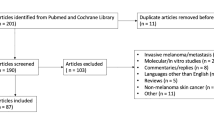Summary
Background Despite multiple available options, the treatment of cutaneous melanoma metastases is often unsuccessful. Based on the hypothesis that imiquimod and 5-fluorouracil have synergistic antitumor properties, we used this topical combination to treat several patients. Aim Our objective was to investigate the treatment combination in a small cohort of patients with surgically non-resectable melanoma metastases. Methods The lesions of 5 patients with multiple cutaneous metastases were treated topically, 5 days per week, with 5-fluorouracil in the morning and imiquimod at night. Results 45 lesions were treated. A clinical response was seen in 44 lesions, with a complete response in 19 lesions and a partial response in 25. Stable disease was confirmed in the 1 remaining lesion. No patients developed new lesions during treatment. However, one patient had a recurrence 6 months after treatment discontinuation, followed by a partial response when rechallenged. Conclusions The imiquimod and 5-fluorouracil combination is effective. That patients did not develop new, distant lesions suggests the achievement of locoregional control, probably by the induction of antitumor immune response.




Similar content being viewed by others
References
Rosenberg SA, Rapp HJ (1976) Intralesional immunotherapy of melanoma with BCG. Med Clin North Am 60:419–430
Radny P, Caroli UM, Bauer J, Paul T, Schlegel C, Eigentler TK, Weide B, Schwarz M, Garbe C (2003) Phase II trial of intralesional therapy with interleukin-2 in soft-tissue melanoma metastases. Br J Cancer 89:1620–1626
Hodi FS, O'Day SJ, McDermott DF, Weber RW, Sosman JA, Haanen JB, Gonzalez R, Robert C, Schadendorf D, Hassel JC, Akerley W, van den Eertwegh AJ, Lutzky J, Lorigan P, Vaubel JM, Linette GP, Hogg D, Ottensmeier CH, Lebbé C, Peschel C, Quirt I, Clark JI, Wolchok JD, Weber JS, Tian J, Yellin MJ, Nichol GM, Hoos A, Urba WJ (2010) Improved Survival with Ipilimumab in Patients with Metastatic Melanoma. N Engl J Med 363:711–723
Love WE, Bernhard JD, Bordeaux JS (2009) Topical imiquimod or fluorouracil therapy for basal and squamous cell carcinoma: a systematic review. Arch Dermatol 145:1431–1438
Ahmed I, Berth-Jones J (2000) Imiquimod: a novel treatment for lentigo maligna. Br J Dermatol 143:843–845
Steinmann A, Funk JO, Schuler G, von den Driesch P (2000) Topical imiquimod treatment of a cutaneous melanoma metastasis. J Am Acad Dermatol 43:555–556
Wolf IH, Smolle J, Binder B, Cerroni L, Richtig E, Kerl H (2003) Topical imiquimod in the treatment of metastatic melanoma to skin. Arch Dermatol 139:273–276
Bong AB, Bonnekoh B, Franke I, Schön MP, Ulrich J, Gollnick H (2002) Imiquimod, a topical immune response modifier, in the treatment of cutaneous metastases of malignant melanoma. Dermatology 205:135–138
Green DS, Bodman-Smith MD, Dalgleish AG, Fischer MD (2007) Phase I/II study of topical imiquimod and intralesional interleukin-2 in the treatment of accessible metastases in malignant melanoma. Br J Dermatol 156:337–345
Goette DK (1981) Topical chemotherapy with 5-fluorouracil. A review. J Am Acad Dermatol 4:633–649
Ondo AL, Mings SM, Pestak RM, Shanler SD (2006) Topical combination therapy for cutaneous squamous cell carcinoma in situ with 5-fluorouracil cream and imiquimod cream in patients who have failed topical monotherapy. J Am Acad Dermatol 55:1092–1094
Makower D, Wadler S (1999) Interferons as biomodulators of fluoropyrimidines in the treatment of colorectal cancer. Semin Oncol 26:663–671
Hemmi H, Kaisho T, Takeuchi O, Sato S, Sanjo H, Hoshino K, Horiuchi T, Tomizawa H, Takeda K, Akira S (2002) Small anti-viral compounds activate immune cells via the TLR7 MyD88-dependent signaling pathway. Nat Immunol 3:196–200
Wagner TL, Ahonen CL, Couture AM, Gibson SJ, Miller RL, Smith RM, Reiter MJ, Vasilakos JP, Tomai MA (1999) Modulation of TH1 and TH2 cytokine production with the immune response modifiers, R-848 and imiquimod. Cell Immunol 191:10–19
Schön MP, Wienrich BG, Drewniok C, Bong AB, Eberle J, Geilen CC, Gollnick H, Schön M (2004) Death receptor-independent apoptosis in malignant melanoma induced by the small-molecule immune response modifier imiquimod. J Invest Dermatol 122:1266–1276
Hesling C, D'Incan M, Mansard S, Franck F, Corbin-Duval A, Chèvenet C, Déchelotte P, Madelmont JC, Veyre A, Souteyrand P, Bignon YJ (2004) In vivo and in situ modulation of the expression of genes involved in metastasis and angiogenesis in a patient treated with topical imiquimod for melanoma skin metastases. Br J Dermatol 150:761–767
Powell AM, Robson AM, Russell-Jones R, Barlow RJ (2009) Imiquimod and lentigo maligna: a search for prognostic features in a clinicopathological study with long-term follow-up. Br J Dermatol 160:994–998
Stefanaki C, Nicolaidou E, Hadjivassiliou M, Antoniou C, Katsambas A (2006) Imiquimod-induced vitiligo in a patient with genital warts. J Eur Acad Dermatol Venereol 20:755–756
Gowda S, Tillman DK, Fitzpatrick JE, Gaspari AA, Goldenberg G (2009) Imiquimod-induced vitiligo after treatment of nodular basal cell carcinoma. J Cutan Pathol 36:878–881
Mashiah J, Brenner S (2008) Possible mechanisms in the induction of vitiligo-like hypopigmentation by topical imiquimod. Clin Exp Dermatol 33:74–76
Funding source
None.
The authors declare they have no conflict of interest to declare.
Author information
Authors and Affiliations
Corresponding author
Rights and permissions
About this article
Cite this article
Florin, V., Desmedt, E., Vercambre-Darras, S. et al. Topical treatment of cutaneous metastases of malignant melanoma using combined imiquimod and 5-fluorouracil. Invest New Drugs 30, 1641–1645 (2012). https://doi.org/10.1007/s10637-011-9717-2
Received:
Accepted:
Published:
Issue Date:
DOI: https://doi.org/10.1007/s10637-011-9717-2




